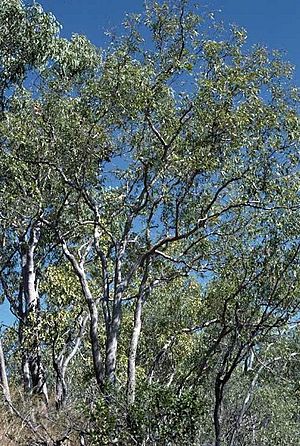Jacob's bloodwood facts for kids
Quick facts for kids Jacob's bloodwood |
|
|---|---|
 |
|
| Corymbia jacobsiana near Pine Creek | |
| Scientific classification | |
| Genus: |
Corymbia
|
| Species: |
jacobsiana
|
| Synonyms | |
|
Eucalyptus jacobsiana Blakely |
|
Jacob's bloodwood, also called the stringybark bloodwood, is a special tree. It only grows in the Northern Territory of Australia. This tree has rough, stringy bark on its trunk and branches. It also has unique leaves, creamy white flowers, and fruit shaped like an urn.
Contents
What Does Jacob's Bloodwood Look Like?
Jacob's bloodwood is a tree that can grow up to 20 metres (about 65 feet) tall. It has rough, stringy bark that is yellow-brown to grey-brown. This bark covers both its trunk and branches.
Leaves and Flowers
Young plants have shiny, dark green leaves. These leaves are long and narrow, about 45 to 105 mm (1.8 to 4.1 inches) long. They are also a bit hairy and paler on their underside.
Older trees have different leaves. They are shiny dark green on top and much paler underneath. These leaves are shaped like a spear or an oval. They are about 53 to 137 mm (2.1 to 5.4 inches) long.
The tree's flower buds grow in groups of three or seven. They are usually oval or pear-shaped. These buds are about 4 mm long. Jacob's bloodwood is thought to flower between February and April. Its flowers are a creamy white colour.
Fruit and Seeds
After flowering, the tree produces woody fruit. These fruits are shaped like an urn and are about 7 to 11 mm (0.3 to 0.4 inches) long. Inside the fruit are flat, dull red or red-brown seeds.
Jacob's bloodwood is quite unique. It doesn't have many close relatives among other bloodwood trees. You can tell it apart by its rough, stringy bark and its slightly hairy young leaves.
How Did Jacob's Bloodwood Get Its Name?
This tree was first officially described in 1934 by a botanist named William Blakely. He called it Eucalyptus jacobsiana. The first samples of the tree were collected in 1933. They were found near Pine Creek by Dr. Maxwell Ralph Jacobs. He was a famous forester. The tree was named jacobsiana in his honour.
Later, in 1995, two other botanists, Ken Hill and Lawrie Johnson, decided that some trees, including the bloodwoods, were different enough from Eucalyptus to be in their own group. They created a new group called Corymbia. That's why the tree's name was changed to Corymbia jacobsiana.
Where Does Jacob's Bloodwood Grow?
Jacob's bloodwood grows in the Top End of the Northern Territory. It likes to grow in areas with monsoonal woodlands. These are forests that get a lot of rain during the wet season. You can often find it mixed with other eucalyptus trees and cypress trees. It grows in sandy or clay soils.
You might find this tree in places like Pine Creek, Tipperary Station, and further east in Arnhem Land. It often grows alongside other bloodwood trees like Corymbia arnhemensis.
This tree has special underground stems called rhizomes. These help it grow back quickly after bushfires. After a fire, many new trees can sprout, forming dense groups. Over time, these groups thin out to become woodlands.

